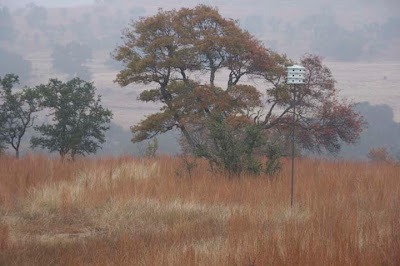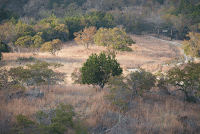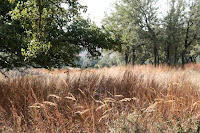
Bare trees on a hillside tend to look alike unless you look specifically at tree shape, bark color and pattern.
Every winter I play a little game with myself. I like to see how many trees I can identify using tree shape, bark patterns and color. Sometimes I can identify them, but not always. Tree shapes are variable, and many trees have so many lichens growing on their bark that it is hard to see a bark pattern. Young bark looks different from old bark.
This week I'd like to share with you some of the characteristics that help. Trees assume many shapes that are determined by the conditions around them, such as availablity of water, whether they are alone in a sunny space, or shaded and/or crowded in thick woods. Trees in an open area are more apt to show a classic shape than those in crowded conditions.
Note: Most tree identification books use leaves as the primary identifying feature. Defining clues include whether leaves are simple (one blade per leaf) or compound (2 or more leaflets per leaf), its shape (round, triangular, heart shaped, etc.), leaf edges (smooth, sawtoothed, lobed, etc.) and the attachment of leaves on their twigs (opposite or alternate).
Oaks here will be the subject for this blog. The most abundant oak we see at Selah is Plateau Live oak, which is an evergreen meaning it keeps its leaves all winter. For this blog, I'll be writing about deciduous trees, which are those that lose their leaves in winter.
Deciduous oaks that are native to Selah: Bur, Blackjack, Bigelow, Lacey, Post, Shin, Spanish (also known as Texas oak). (the oaks I feature in this blog are in bold)
Deciduous oaks that are introduced here: Chinkapin, Monterey, Vasey.
Oaks that have leaves with obvious points on them are in the Red Oak group and have tannins in their leaves and acorns. Also,they turn colors such as red in the fall. Those oaks with leaves without points are in the White Oak group and don't have tannins, and they have little fall color and usually turn brown before they fall.
Of the oaks on Selah, the Bur oak is typically a large oak (up to 150 feet) with huge leaves 6 to 12 inches long with multiple rounded lobes, and acorns up to 2 inches long. Their limbs are straight. They need deep soils and constant water. Bark is grey, thick, with deep fissures, and are broken into narrow plates. The bur oak below was planted along Madrone Lake by J. David in 1987. It is now around 25 feet tall and doing well. There is a huge Bur oak in Sun Valley Pasture that has a creek running through it, and as far as we know it is growing there naturally.
The most common of the deciduous oaks on Selah are Spanish oaks, which line the upper slopes and are found scattered across the landscape here. They can be handsome trees usually under 35 feet tall. Their limbs are sometimes bent, and the overall shape of the tree is frequently irregular. They seem to have weak trunk and branch structure and break easily in wind storms and ice storms. The wood can be used for burning, but not for lumber. The bark is light grey, unless covered with lichens, and the depth of the furrows depends on their age. Their leaves have deep narrow lobes with long points at the ends. In blog #2 (December 9) I have a picture that shows scarlet color that some of them turn. Others turn orange-red or orange.
Spanish oak is the most susceptible oak to oak wilt, which is a fungal infection that spreads from tree to tree through their roots when in they are in contact underground. Also it is spread by sap beetles that carry the fungus from a wound in one tree to other trees and start new centers of infection.
Shin oaks are found in a number of different areas, and how they look depends on both the depth of soil and the amount of water available to them. In deep soil they may be handsome small trees up to 30 feet tall (called Bigelow oaks), and in rocky limestone soil a small slender tree. It sometimes is found in a thick growth of brush known as "shineries". The 2 trees pictured below are on the edge of a valley that leads to a spring. The bark is typical of Shin oaks, thin, light grey, and peeling in vertical sheets.

This tangle of oaks is referred to as a shinnery. They grow like this when the original trees are cut down or burned in a fire and new shoots arise from the roots. These thick oak tangles are the favored habitat of the endangered Black-capped vireo. When the shinneries get too tall, they look for other habitat. The one pictured is getting close to being too tall.
Post oaks and Blackjack oaks are mostly in an area of the ranch which is on the plateau tops where the soils are red, and contain a high content of silica (the stuff glass is made of). They like silica rich soils, and are very common in Bastrop County, and other locations with sandy soils. The Post oak is the more common of the two, but Blackjacks are almost always found in Post oak woodlands, and my guess would be that there is one Blackjack oak for every ten or so Post oaks.
Post oaks are members of the White Oak family, and their leaves turn brown in the fall. The edges of their lobed leaves are rounded and often have a shape that is similar to a cross. Their acorns are sweet, and free of tannins, which makes them desirable to eat. Their branches are stout, with lots of bends in them. The bark color is a much lighter grey than blackjacks. The bark is thick with deep vertical fissures and longitudinal fissures that divide the bark into rectangular plates. I find them very attractive in the winter.
Blackjack oaks have leaves that turn rusty-red in the fall. The classic leaf is shaped sort of like a duck foot, narrow at the base and at the upper end 3 lobes with pointed tips. The shape of the tree without leaves is less regular than Post Oaks. The furrows on the bark are deep. The dark grey, almost black bark has a knobby look with blocky plates.
Post oaks are members of the White Oak family, and their leaves turn brown in the fall. The edges of their lobed leaves are rounded and often have a shape that is similar to a cross. Their acorns are sweet, and free of tannins, which makes them desirable to eat. Their branches are stout, with lots of bends in them. The bark color is a much lighter grey than blackjacks. The bark is thick with deep vertical fissures and longitudinal fissures that divide the bark into rectangular plates. I find them very attractive in the winter.
Blackjack oaks have leaves that turn rusty-red in the fall. The classic leaf is shaped sort of like a duck foot, narrow at the base and at the upper end 3 lobes with pointed tips. The shape of the tree without leaves is less regular than Post Oaks. The furrows on the bark are deep. The dark grey, almost black bark has a knobby look with blocky plates.
I hope that even if you don't become good at identifying winter trees, you will look at and appreciate the shapes of the bare branches against the sky, as well as the color and patterns of the bark of the bare trees around you. Noticing differences makes the season more interesting.
"Selah Moments" are times when you are outdoors and notice and enjoy some aspect of nature that seems special to you. For some it might be a bird song, or seeing an insect, or the sound of wind in the trees, or wind blowing grasses in waves across a field, or simply the beauty of sunlight, or clouds. So don't forget to go outdoors and take out time to notice and record in your memory those special moments.
My favorite Selah moment this week occurred when a group of us were walking in the woods on the Aldo Leopold trail late in the afternoon on the day of the Winter Solstice. We were enjoying each other's company when we arrived at an area with large boulders scattered about and a friend said, "Let's all sit down here for a few minutes and enjoy a Selah Moment." It takes a few seconds to move from walking and talking to quiet attention. There was a gentle wind blowing and I could hear it in the tree branches and when it blew through the leaves of the Live oak trees. The moon had just risen, and the sky was starting to show late afternoon pink in the west. It was a magical moment.
Many thanks to Chris Johnson who has helped so much with this blog. I call him anytime I can't figure out how to accomplish something. He also fixes the arrangement of elements in the final version that are beyond my abilities at this time.
Look for another post in a about week, which will be next year. Have a fun, safe New Year's Eve, and a adventurous, healthy, happy year in 2008.






























